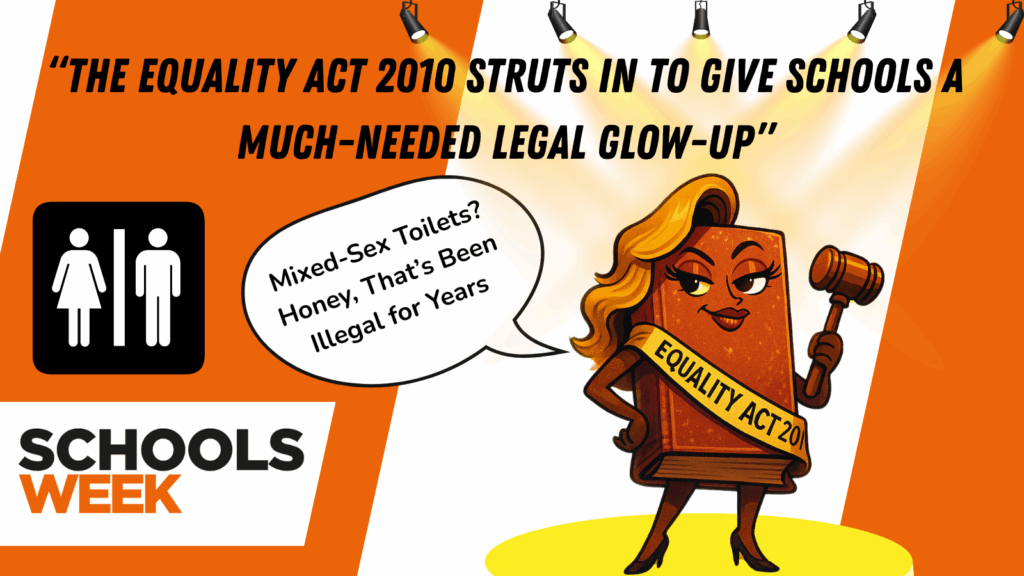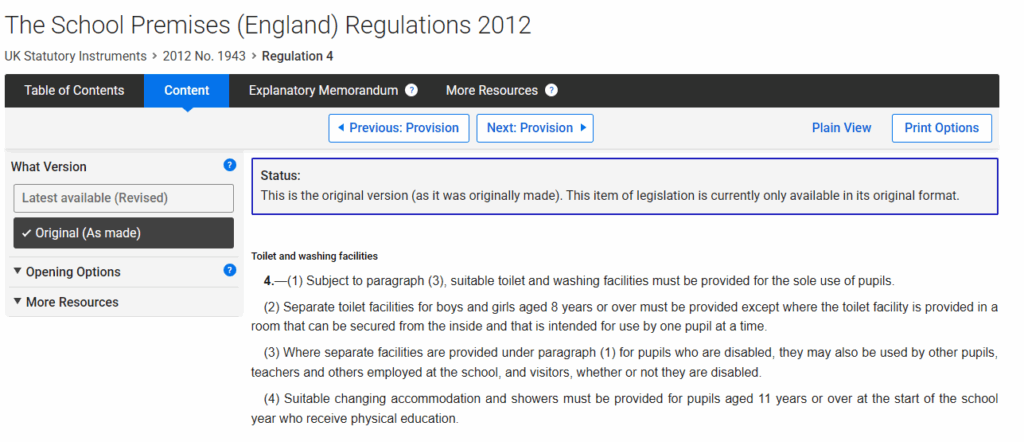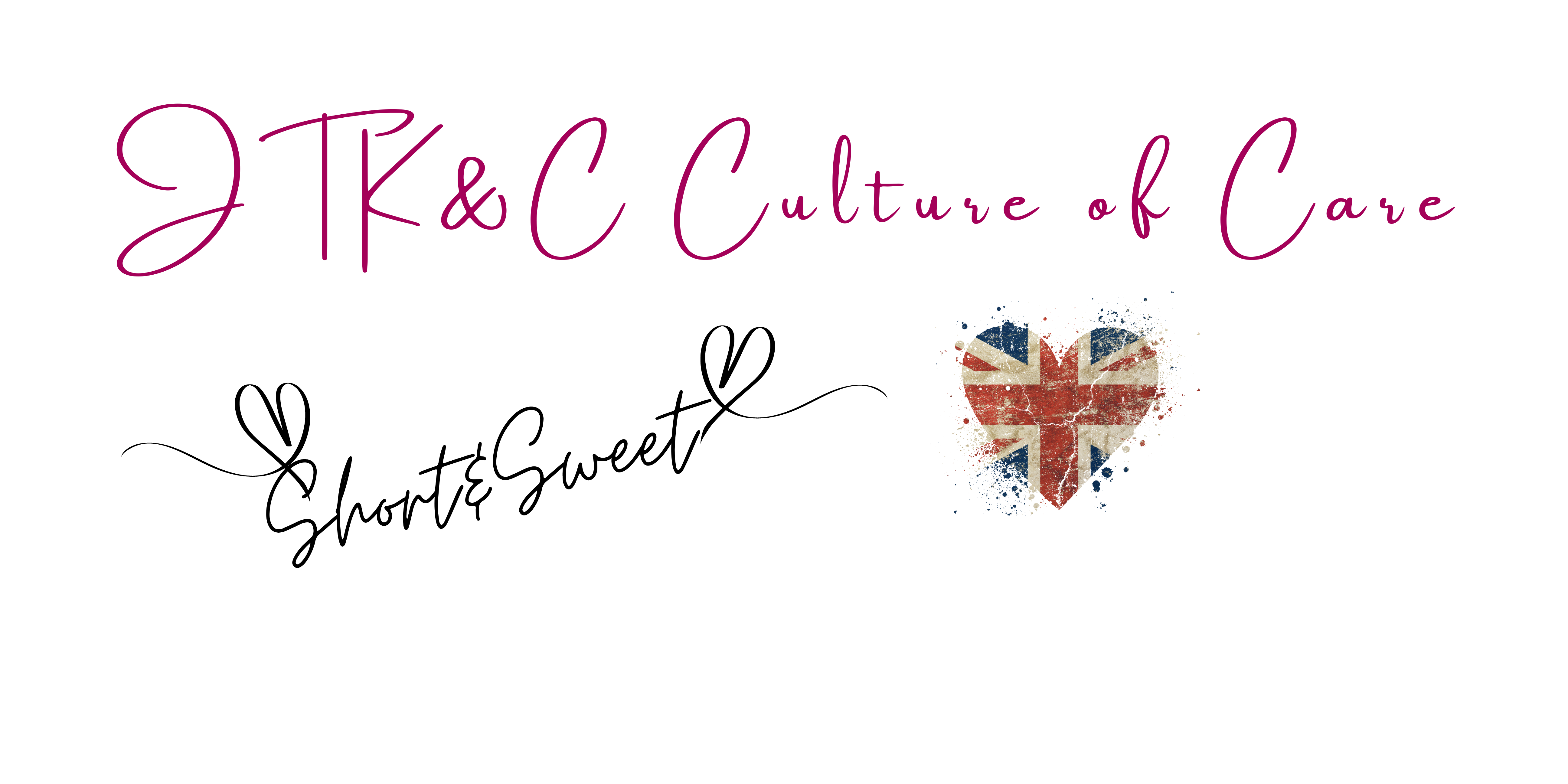Okay peeps, buckle up because this Schools Week article is serving confusion with a side of legal missteps, and I’m here to clear the air with some sass and a whole lot of legislative receipts. Titled “EHRC guidance causes trans toilet trouble for schools,” it’s trying to unpack the Equality and Human Rights Commission’s (EHRC) interim update on toilet arrangements for trans pupils, but it stumbles harder than a toddler trying to walk in their mum’s heels. Let’s break down why this article fails to grasp the laws governing schools, with a sprinkle of shade and a firm grip on the actual legislation —plus a sharp jab at its safeguarding fumble.

Misreading the Equality Act 2010 Like It’s a Choose-Your-Own-Adventure Book
The article dives into the EHRC’s interim guidance, which clarifies that “pupils who identify as trans girls should not be permitted to use the girls’ toilet or changing facilities” and vice versa for trans boys. It’s grounded in the Supreme Court’s ruling that “woman” in the Equality Act 2010 means a biological female (Equality Act 2010, s.212). The EHRC doubles down, stating that “sex” is binary—male or female—based on birth certificates (EHRC Guidance, 2025). Yet, the article fumbles by suggesting schools are left in a lurch about “suitable alternative provisions” for trans pupils.
Newsflash: The law isn’t vague here. Schools have been required to provide single-sex toilets for pupils over 8 and changing facilities for those over 11 since forever (School Premises (England) Regulations 2010, Reg. 4). The EHRC’s update just reiterates that these facilities are for biological males and females. If a trans pupil needs an alternative, schools can use single-user, lockable rooms—already permitted under the same regulations. The article’s hand-wringing over “clarity” ignores that the law’s been clear since 2010. It’s not rocket science; it’s basic maths, 1+1=2.

Whining About “Safeguarding” Without Reading the Fine Print
Clare Wigzell, quoted in the article, laments that the guidance doesn’t explain how schools can “ensure trans pupils are safeguarded and not subjected to unfavourable treatment” under the Equality Act’s gender reassignment protections (Equality Act 2010, s.7). Oh, please. The Equality Act doesn’t mandate that trans pupils use opposite-sex facilities to avoid discrimination. Schools can provide gender-neutral, single-user facilities without violating the Act.
The article’s implication that schools are stuck in a legal paradox is pure drama. Safeguarding duties under the Education Act 2002, s.175 require schools to protect all pupils, not to let trans pupils use facilities misaligned with their biological sex. The EHRC’s guidance aligns with this by suggesting “suitable alternatives” like accessible toilets, which the article admits some schools already use. So why the sob story? The law’s got this covered, but the article’s acting like it’s auditioning for an episode of Grange Hill.
Failing Safeguarding 101 and Ignoring Keeping Children Safe in Education
Let’s talk about the article’s epic face-plant on safeguarding, shall we? It vaguely nods to schools’ duties to “safeguard” trans pupils but doesn’t once mention the Keeping Children Safe in Education (KCSIE) guidance, the Bible of school safeguarding (KCSIE, 2024). KCSIE mandates that schools create a safe environment for all pupils, with policies that prioritise welfare and prevent harm, including in facilities like toilets. By fretting over the EHRC’s guidance without referencing KCSIE, the article misses that schools allowing mixed-sex toilets (yep, 25% of them) are already failing their safeguarding duties. KCSIE emphasises risk assessments for pupil safety—mixed-sex facilities for children over 8 scream privacy and safety risks, especially for vulnerable groups. The article’s silence on how these non-compliant schools have been skating by, potentially exposing children to harm, is journalistic malpractice. Instead of crying about “clarity,” it should be grilling schools for ignoring KCSIE’s call to ensure safe, sex-segregated spaces.
Mixed-Sex Toilets? Honey, That’s Been Illegal for Years
The article cites a Teacher Tapp survey claiming 25% of schools have mixed-sex toilets, implying they’re now in hot water. Cue the violins. Except, mixed-sex toilets for pupils over 8 have been non-compliant since the School Premises (England) Regulations 2010 and the Education (Independent School Standards) Regulations 2010, Part 5, para. 23. These laws mandate separate facilities for boys and girls, with the only exception being single-user, lockable rooms. If a quarter of schools are flouting this, that’s not the EHRC’s fault—it’s a compliance issue schools should’ve fixed a decade ago.
The article’s pearl-clutching over schools needing to “invest in new facilities” is just lazy reporting. Schools with mixed-sex blocks were already breaking the law, EHRC guidance or not. The Supreme Court ruling and EHRC update just shine a spotlight on their oopsie and severe lack of safeguarding protocols! Instead of framing this as a new burden, the article should be calling out schools for ignoring regs that have been in place since One Direction was topping the charts.
Staff Facilities? The Article’s Confusion Is Next-Level
The article really trips over itself when it tackles staff facilities, quoting the EHRC that trans staff can’t use facilities matching their identified gender and might be barred from both male and female facilities in some cases. A school leader calls this “absurd,” and the article leans into the chaos narrative. But let’s pump the brakes. The EHRC is summarising the Equality Act’s provisions for single-sex spaces (Equality Act 2010, Sch. 3, Part 7), which allow service providers to exclude trans individuals from certain facilities if it’s a “proportionate means of achieving a legitimate aim” (like privacy or safety).
The article misses that employers can offer gender-neutral options for staff, just like for pupils, without leaving anyone “with nowhere to go.” The Workplace (Health, Safety and Welfare) Regulations 1992 already require “suitable and sufficient” facilities, which can include unisex toilets. The EHRC’s point is that trans staff don’t get a free pass to use single-sex facilities, but schools can’t just shrug and leave them high and dry (though if they really cared about safeguarding adults wearing their fetish to work shouldn’t be within 10 feet of a school or classroom!). The article’s hysteria over this “absurd picture” is just bad legal comprehension dressed up as journalism.
The DfE’s Guidance Delay Isn’t the EHRC’s Problem
The article throws shade at the EHRC’s interim update, calling it a “snapshot reflection” per Baroness Jacqui Smith and noting the Department for Education (DfE) won’t issue full guidance until later in 2025. Boo-hoo. The EHRC’s job is to interpret the law, not hold schools’ hands through every scenario. The Education Act 1996 and 2002 already set clear standards for school premises, and the EHRC’s guidance aligns with them. If the DfE’s dragging its feet, that’s on them, not the EHRC.
The article’s attempt to paint the EHRC as the villain for not spoon-feeding schools is tired. Schools have the legal framework—Equality Act, School Premises Regulations, and all—to make compliant decisions. The EHRC’s interim note is a helpful nudge, not a legal landmine. Stop whining and start reading the statutes, folks.
This Article Needs a Legal Glow-Up
Listen, Schools Week, we get it—trans toilet policies are a hot topic, and you want clicks. But this article’s attempt to stir panic over the EHRC’s guidance is a masterclass in missing the point.
The laws are clear: single-sex facilities are mandatory, based on biological sex, with alternatives like single-user toilets already baked into the regulations (School Premises (England) Regulations 2010; Education (Independent School Standards) Regulations 2010). The Equality Act protects pupils and staff without mandating access to opposite-sex spaces, and safeguarding duties, including KCSIE, don’t require schools to rewrite the rulebook.
Instead of hyping up “trouble” and “absurdity,” how about focusing on schools’ failure to comply with decade-old laws or the DfE’s slow roll on guidance? The EHRC’s interim update isn’t the problem—it’s the mirror schools don’t want to look into. Next time, bring some legal savvy to the table, and maybe we’ll talk. Until then, sashay away with your ideological drivel and let the statutes do the talking.
References:
- Schools Week EHRC guidance causes trans toilet trouble for schools https://schoolsweek.co.uk/ehrc-guidance-causes-trans-toilet-trouble-for-schools/#comment-216787
- Education Act 1996
- School Premises (England) Regulations 2010
- Education Act 2002
- Education (Independent School Standards) Regulations 2010
- Equality Act 2010
- Workplace (Health, Safety and Welfare) Regulations 1992
- EHRC Guidance, 2025
- KCSIE, 2024 Keeping Children Safe in Education, 2024
- https://www.womensrights.network/school-toilets
